THE 2018 GLEN HELEN NATIONAL LIKE YOU’VE NEVER SEEN IT: THE DAY BEFORE THE ACTION STARTS
 A small view of the overall layout. The start is to the left and the finish line is to the right, but this photo shows the long climb up to the flag pole, but not the rapid descent to the bottom a second later.
A small view of the overall layout. The start is to the left and the finish line is to the right, but this photo shows the long climb up to the flag pole, but not the rapid descent to the bottom a second later.
Photos by Debbi Tamietti
The Glen Helen National is unique—not just because the track is so big, but because Glen Helen holds up to four races a weekend on its two motocross track, Supercross track, Lucas Oil Offroad Truck track and 900 acres of cross-country trails. That means that Glen Helen is constantly in use. The only time it is shut down to racing is in the week before the annual Glen Helen National. During the week before the National it is descended on by hundreds of workers, lots of heavy equipment, fence crews, sound engineers, track workers, electronic technicians and volunteers who just want to help.
The track design was determined almost four months earlier by Jody Weisel and Karl Scanlon. And sections of it have been used in a wide variety of local races, then changed and raced on again. Nothing is left to chance. The actual footprint of the track, in its entirety is laid down two months before the National, but the obstacles wait until the final few days. Why wait? Because everything has to be fresh for the Glen Helen National.
MXA’s ace photographer Debbi Tamietti made the trek to Glen Helen on a day when no one was riding on it (although a hand-picked small group of test riders had be assigned to come early in the morning to test the biggest jumps). What could she possibly find to shoot at a track that was still being set up and wouldn’t be raced on for anther day. Take a look.
 Former Pro racer and MXA test rider Ron Bamgartner (plaid) constructs a special tower that wil greet spectators when they head towards the tunnels that lead to the infield.
Former Pro racer and MXA test rider Ron Bamgartner (plaid) constructs a special tower that wil greet spectators when they head towards the tunnels that lead to the infield.
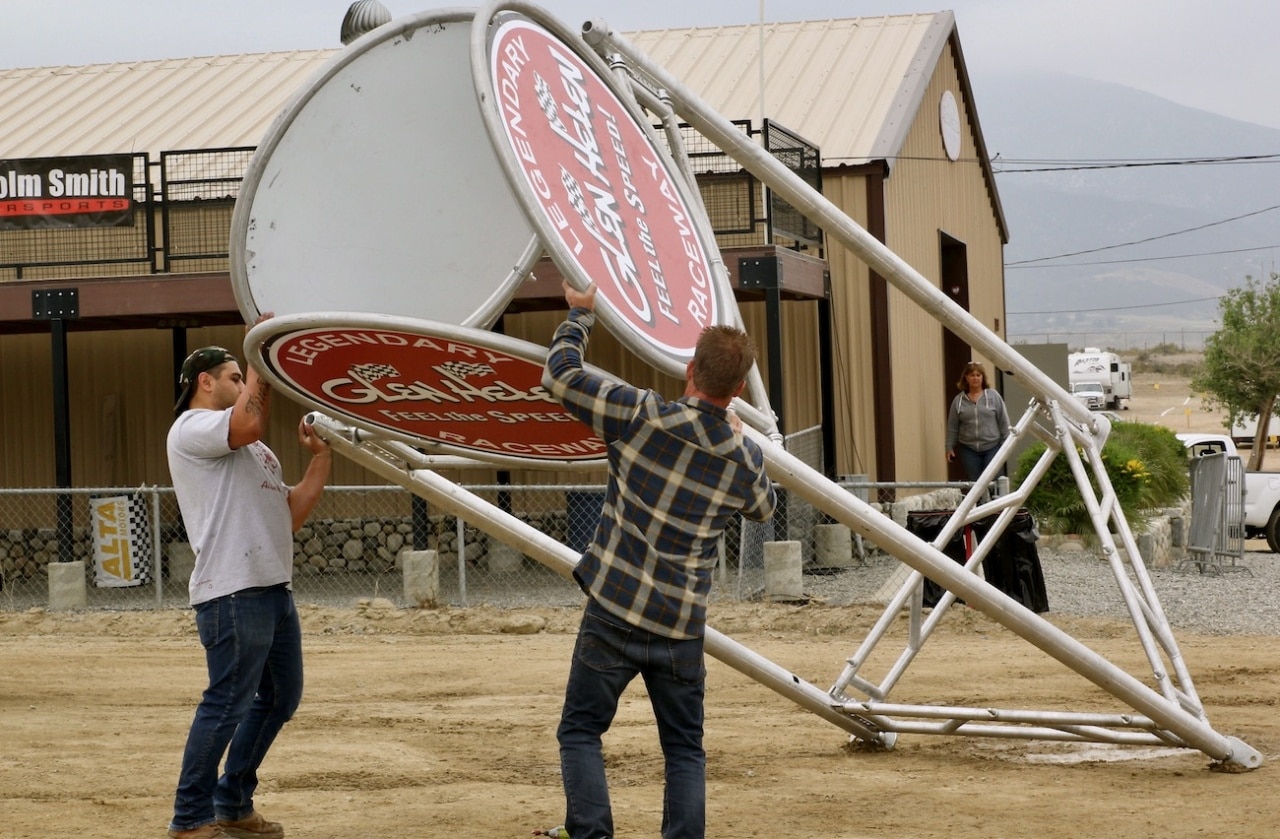 Once the main structure is built, Ron and his buddy stand the tower up. Three large signbords will be attached from a ladder.
Once the main structure is built, Ron and his buddy stand the tower up. Three large signbords will be attached from a ladder.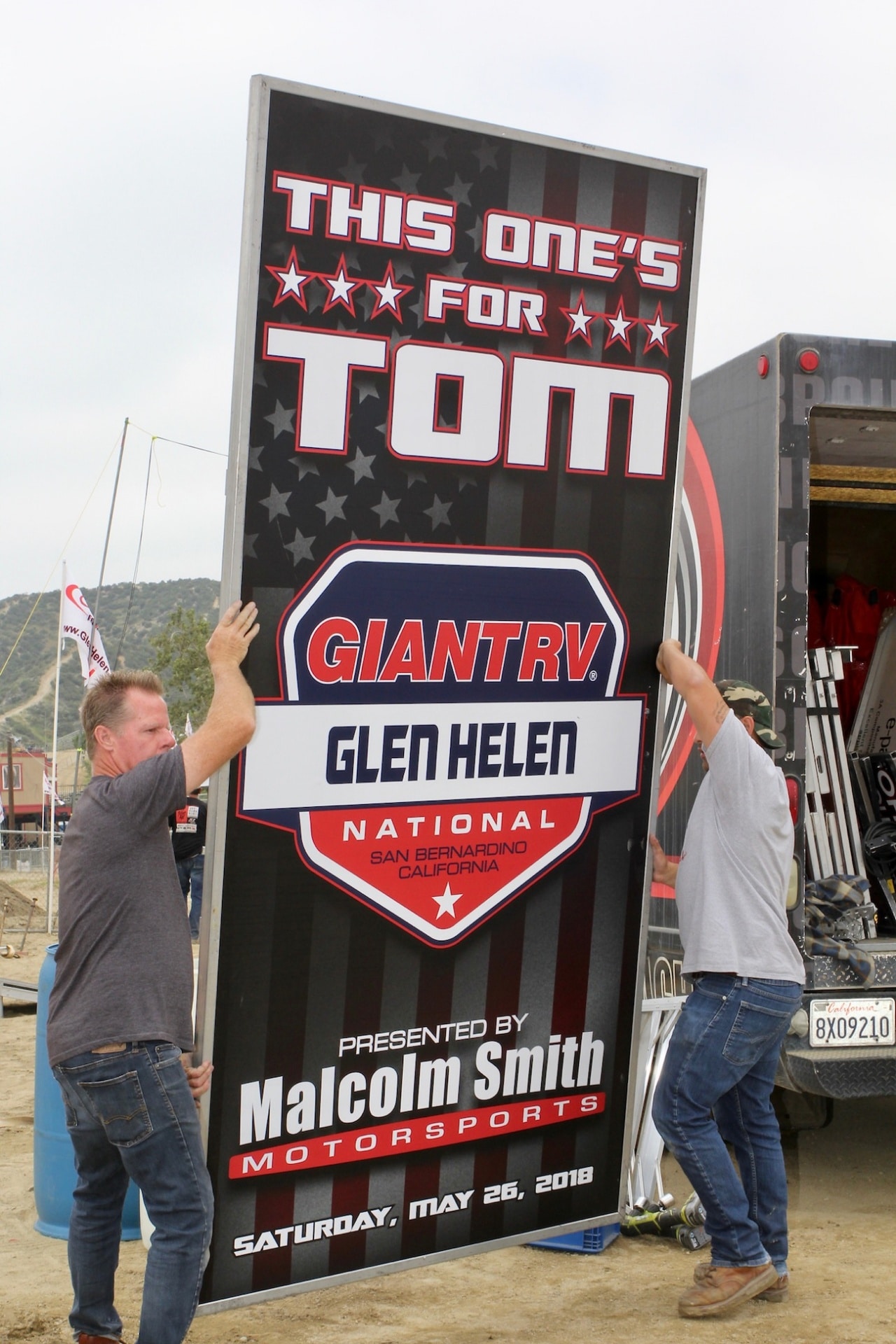 Surprise! Two of the three signs have been designed to honor Tom White. Tom raced at Glen Helen right up until passing away from cancer on the eve of his Dubya World Vet Championship this winter. Tom worked tirelessly to support the sport—from pioneering his White Brothers Cycle Specialties company to promoting the World Vet Championship to guiding the AMA Hall of Fame to building his own motocross museum. Tom was special to Glen Helen and they want to show it.
Surprise! Two of the three signs have been designed to honor Tom White. Tom raced at Glen Helen right up until passing away from cancer on the eve of his Dubya World Vet Championship this winter. Tom worked tirelessly to support the sport—from pioneering his White Brothers Cycle Specialties company to promoting the World Vet Championship to guiding the AMA Hall of Fame to building his own motocross museum. Tom was special to Glen Helen and they want to show it.
 This year, the only way to cross the track during the races is over the bridge—which is adorned with flags to honor the nations of the riders present. If you use the bridge do not stop on it, because it has two-way traffic and everyone wants to get to the the other side—not bump into you. Between races there is a manned gate that will be opened to allow people to cross back and forth.
This year, the only way to cross the track during the races is over the bridge—which is adorned with flags to honor the nations of the riders present. If you use the bridge do not stop on it, because it has two-way traffic and everyone wants to get to the the other side—not bump into you. Between races there is a manned gate that will be opened to allow people to cross back and forth.
 Dr. Bud Feldkmap, himself a winner of the Baja 500 and Baja 1000, saw something in this piece of land almost 30 years ago that no one else saw. He built one of the world’s most famous racetracks on it.
Dr. Bud Feldkmap, himself a winner of the Baja 500 and Baja 1000, saw something in this piece of land almost 30 years ago that no one else saw. He built one of the world’s most famous racetracks on it.
 This is the view from the grandstand section. The track in front goes left, the next track over goes right and the jump in the middle goes towards the long sand section. The giant Talladega first turn is in the background.
This is the view from the grandstand section. The track in front goes left, the next track over goes right and the jump in the middle goes towards the long sand section. The giant Talladega first turn is in the background.
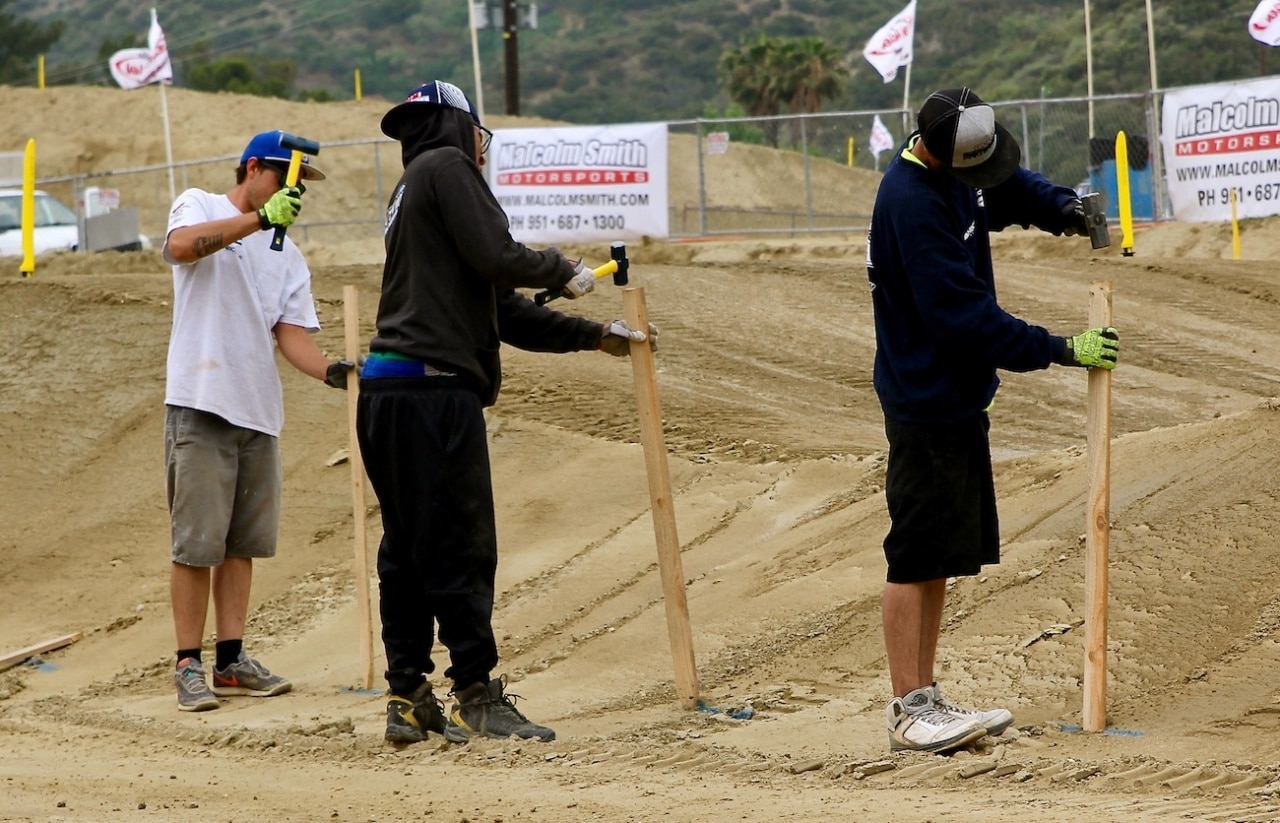 How many stakes can can a track crew drive in a day? There is a special crew that pounds the stakes in the ground one day and hangs banners on them the next day. These are the stakes that hold the irritating repeater banners that sell advertising, but often ruin the spectators view. Welcome to capitalism.
How many stakes can can a track crew drive in a day? There is a special crew that pounds the stakes in the ground one day and hangs banners on them the next day. These are the stakes that hold the irritating repeater banners that sell advertising, but often ruin the spectators view. Welcome to capitalism.
 Ever wonder how signs, fencing, banners, haybales and stakes get to the top of the hills? They are put in the bucket of a top loader and driven almost straight up to their desired locations. This is a scary job when the wheels start spinning on the climb.
Ever wonder how signs, fencing, banners, haybales and stakes get to the top of the hills? They are put in the bucket of a top loader and driven almost straight up to their desired locations. This is a scary job when the wheels start spinning on the climb.
 Who organizes getting everything in place? Who answers all the questions? Who deals with MX Sports? Who is really in charge? Who doesn’t get much sleep in the week leading up to the National? It all falls of Lori Wilson—who knows everything about Glen Helen and everybody who races there.
Who organizes getting everything in place? Who answers all the questions? Who deals with MX Sports? Who is really in charge? Who doesn’t get much sleep in the week leading up to the National? It all falls of Lori Wilson—who knows everything about Glen Helen and everybody who races there.
 Jody Weisel and Duke Finch discuss a quick fix to a minor problem with a track fence.
Jody Weisel and Duke Finch discuss a quick fix to a minor problem with a track fence.
 Unlike the old days, haybales don’t line modern tracks anymore. But, they are still required to keep riders on the racetrack, create barriers and direct the flow on the track. Ten years ago Glen Helen used 400 haybales for the AMA National—now they only order 50.
Unlike the old days, haybales don’t line modern tracks anymore. But, they are still required to keep riders on the racetrack, create barriers and direct the flow on the track. Ten years ago Glen Helen used 400 haybales for the AMA National—now they only order 50.
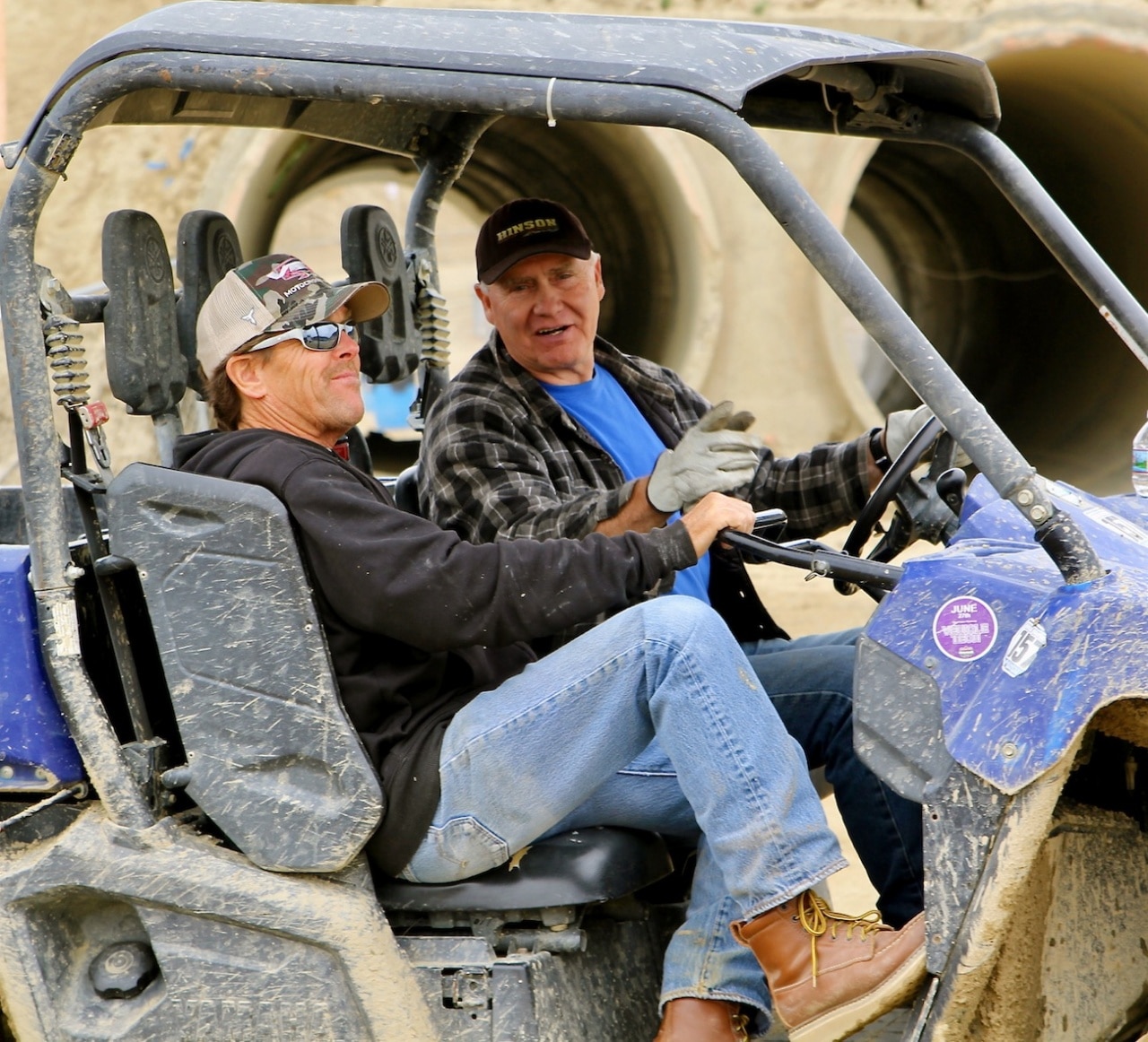 You never know who you will see in the Glen Helen track crew. Here, four-time AMA 250 National Champion Gary Jones (right) helps the fence crew boss, Gary Ball, keep an eye on things. Gary Jones oten promotes offroad races at Glen Helen and just came out to lend a hand for the weekend. Gary Ball ‘s crew fenced the complete racetrack in five days.
You never know who you will see in the Glen Helen track crew. Here, four-time AMA 250 National Champion Gary Jones (right) helps the fence crew boss, Gary Ball, keep an eye on things. Gary Jones oten promotes offroad races at Glen Helen and just came out to lend a hand for the weekend. Gary Ball ‘s crew fenced the complete racetrack in five days.
 After the start, the second turn goes up Mt. Saint Helen. In this view you can see the inside line (over the hump), the outside line (around the hump) and the buffer road between the riders and the fans. This hill is very steep, but only showa a small portion of how high the hill is.
After the start, the second turn goes up Mt. Saint Helen. In this view you can see the inside line (over the hump), the outside line (around the hump) and the buffer road between the riders and the fans. This hill is very steep, but only showa a small portion of how high the hill is.
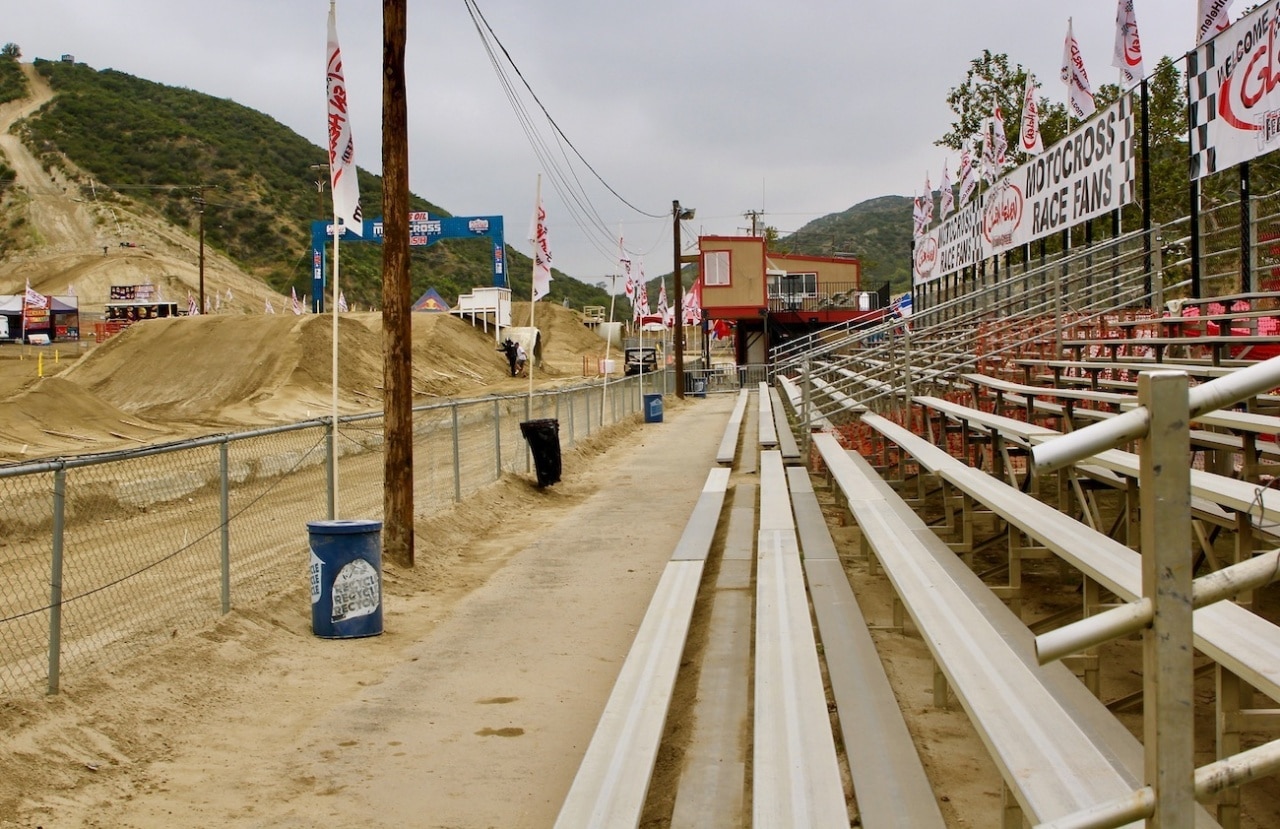 With the all the heavy equipment rolling around, it isn’t exactly quiet at Glen Helen on the day before the racing starts, but the empty grandstands do seem eerily calm without any people in them.
With the all the heavy equipment rolling around, it isn’t exactly quiet at Glen Helen on the day before the racing starts, but the empty grandstands do seem eerily calm without any people in them.
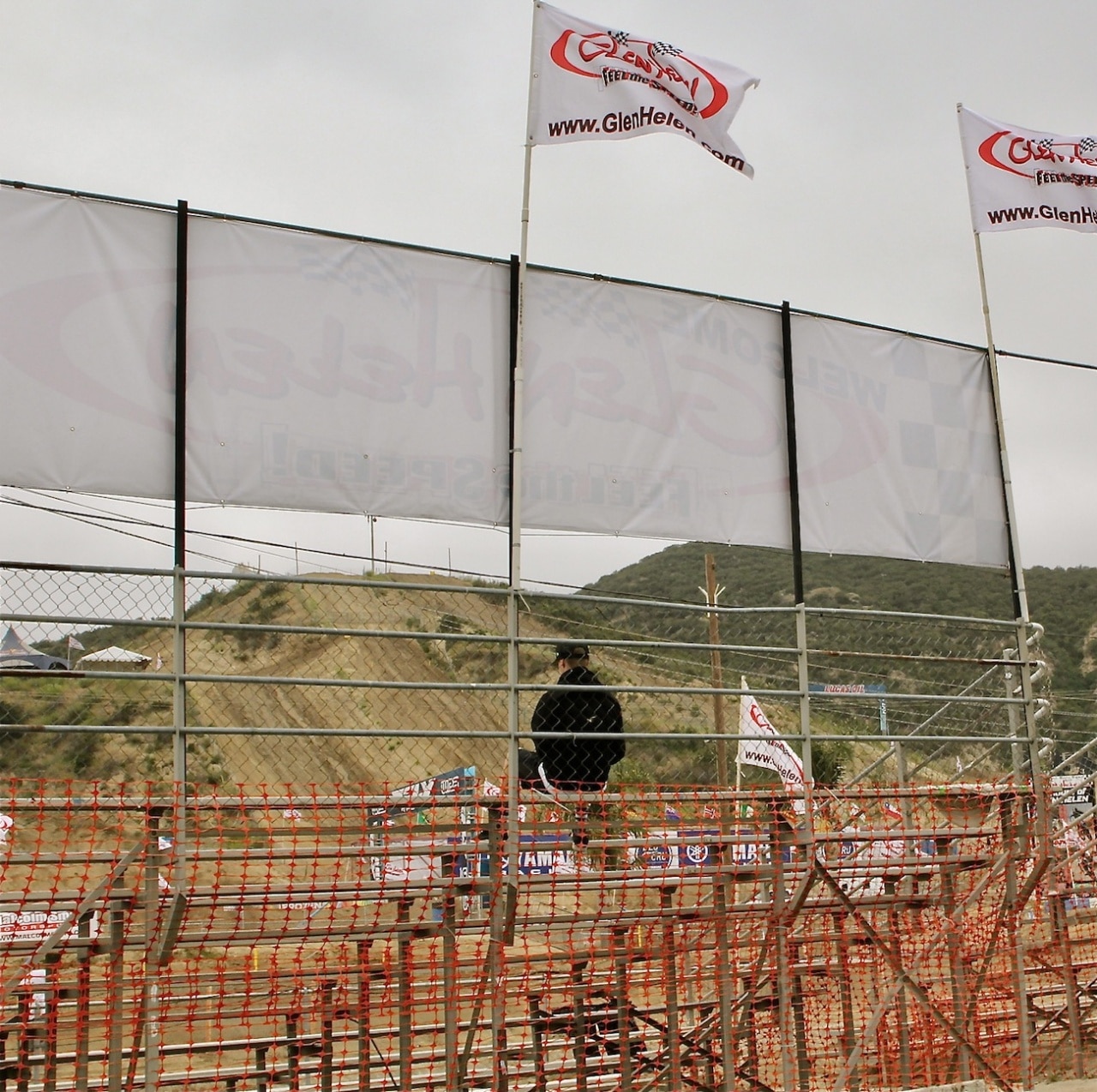 Okay, we lied. There was one lonely spectator staking a claim to his seat for Saturday
Okay, we lied. There was one lonely spectator staking a claim to his seat for Saturday
 It isn’t a race without burritos, nachos, tacos, bacon-wrapped jumbo hot dogs, giant kielbasa, Hawaiian shave ice and frozen lemonade.
It isn’t a race without burritos, nachos, tacos, bacon-wrapped jumbo hot dogs, giant kielbasa, Hawaiian shave ice and frozen lemonade.
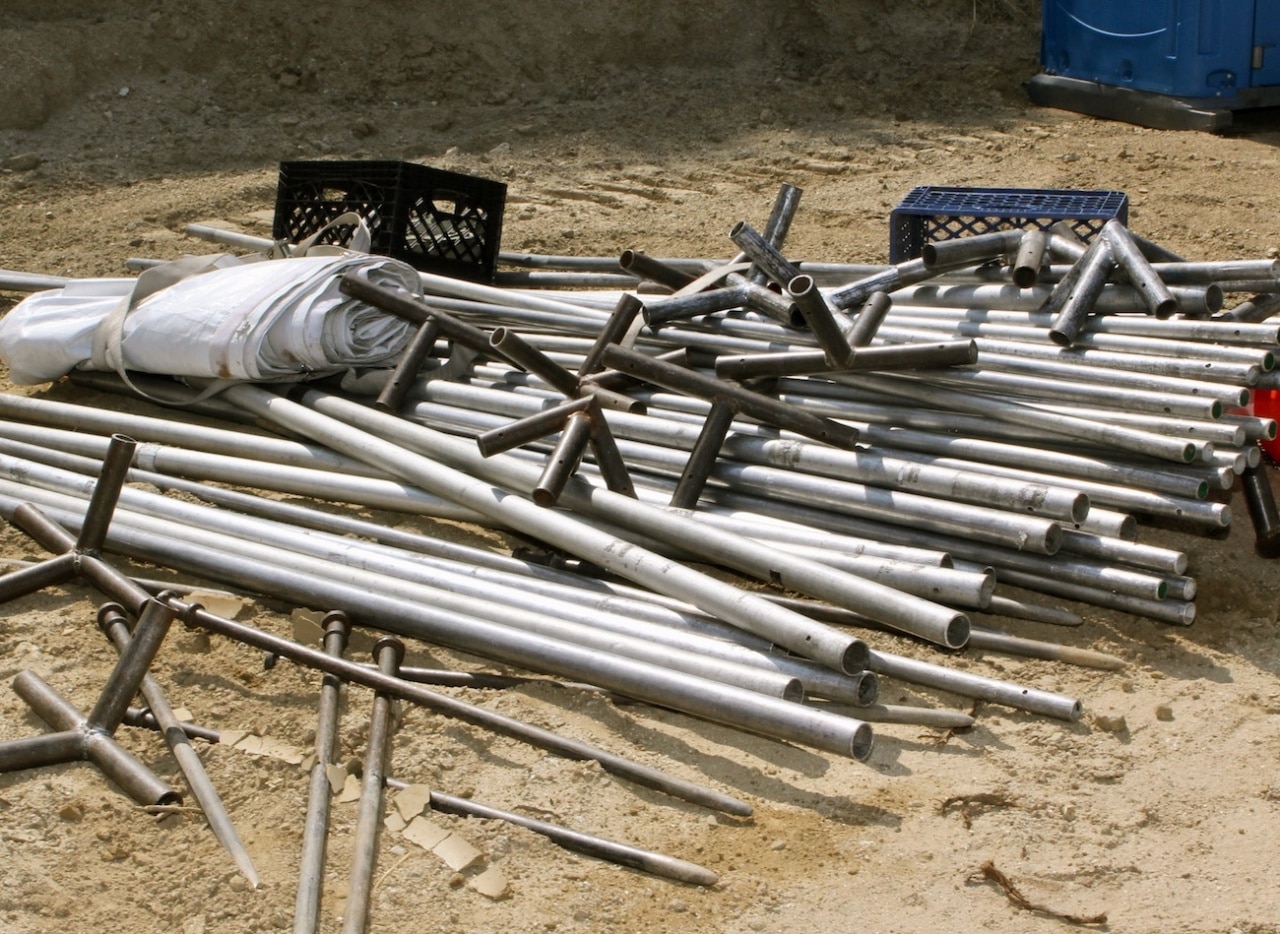 Somebody has to figure this jig-saw puzzle out and build a 20-foot by 40-foot circus tent out it. Amazingly, it take the Party Plus crew about 30 minutes to erect the structure.
Somebody has to figure this jig-saw puzzle out and build a 20-foot by 40-foot circus tent out it. Amazingly, it take the Party Plus crew about 30 minutes to erect the structure.
 Track worker John Allen rips the starting straight with the “three-way.” It rips, harrows and lawn mower shreds the dirt at the same time—although before the three-way goes to world the Cats and road grader churns the dirt up deeply with their ripper teeth. At the National the start is groomed to perfect before every moto.
Track worker John Allen rips the starting straight with the “three-way.” It rips, harrows and lawn mower shreds the dirt at the same time—although before the three-way goes to world the Cats and road grader churns the dirt up deeply with their ripper teeth. At the National the start is groomed to perfect before every moto.
 Almost all of the jumps are placed in front of the grandstand section—with the exception of the Triple Step-Up back by the REM track and the big tabletop in the canyon. The other 90% of the Glen Helen track is sand, hills and natural terrain (well, as natural as a purpose-built racetrack that is used 50 weekends out of the year can be).
Almost all of the jumps are placed in front of the grandstand section—with the exception of the Triple Step-Up back by the REM track and the big tabletop in the canyon. The other 90% of the Glen Helen track is sand, hills and natural terrain (well, as natural as a purpose-built racetrack that is used 50 weekends out of the year can be).
 This is the artwork for the race poster, Glen Helen’s official T-shirt and the third side of the spectator tower. You can buy this T-shirt next to the Glen Helen museum.
This is the artwork for the race poster, Glen Helen’s official T-shirt and the third side of the spectator tower. You can buy this T-shirt next to the Glen Helen museum.
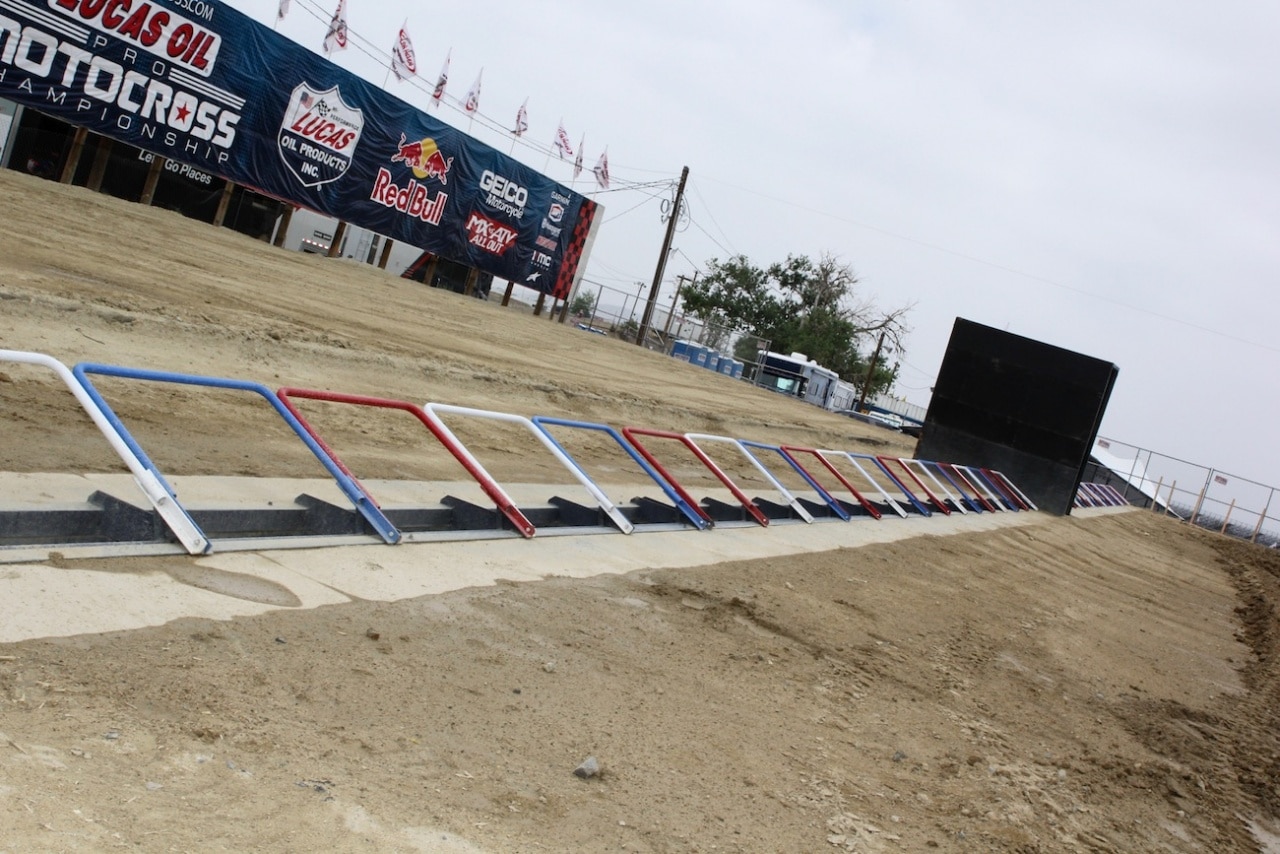 The red, white and blue starting gate is ready for Saturday’s 250/450 National and 250cc Two-Stroke Challenge half-time show—and will be used for today’s amateur event.
The red, white and blue starting gate is ready for Saturday’s 250/450 National and 250cc Two-Stroke Challenge half-time show—and will be used for today’s amateur event.
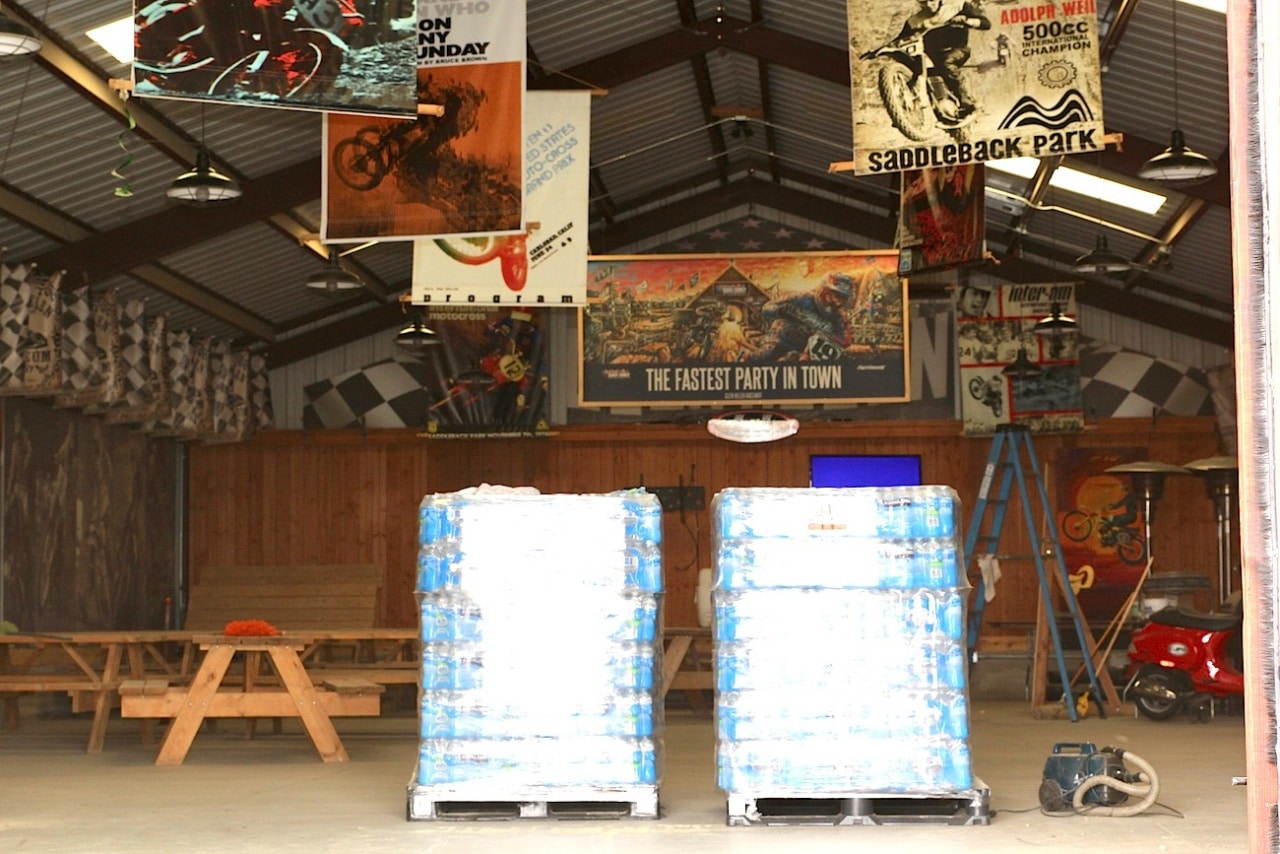 Water is stacked up in front the Glen Helen museum, which has been transformed into the Holeshot Club for the high-rollers.
Water is stacked up in front the Glen Helen museum, which has been transformed into the Holeshot Club for the high-rollers.
 Glen Helen started watering the racetrack and spectator areas a week ago. A fleet of water trucks circled the park soaking everything out of fear that race day would be sunny and 100-degrees. It turns out that it will be 73 degrees and sunny. A perfect race day.
Glen Helen started watering the racetrack and spectator areas a week ago. A fleet of water trucks circled the park soaking everything out of fear that race day would be sunny and 100-degrees. It turns out that it will be 73 degrees and sunny. A perfect race day.
 John Perry is in charge to the 250cc Two-Stroke Challenge race. Glen Helen prefers bigger than 125cc two-strokes as a half-time show (for obvious reasons) and used the 2018 MTA World Two-Stroke Championship as a qualifier for priority acceptance into the Glen Helen class. John and his Yamaha team manager brother Jim Perry are camping in the pits for the weekend—be sure to stop by and say hello (around midnight would be about the perfect time).
John Perry is in charge to the 250cc Two-Stroke Challenge race. Glen Helen prefers bigger than 125cc two-strokes as a half-time show (for obvious reasons) and used the 2018 MTA World Two-Stroke Championship as a qualifier for priority acceptance into the Glen Helen class. John and his Yamaha team manager brother Jim Perry are camping in the pits for the weekend—be sure to stop by and say hello (around midnight would be about the perfect time).




Comments are closed.